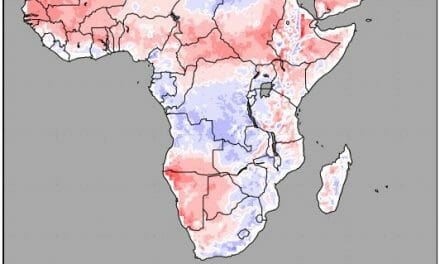
Weather 22 January 2016

What Happened
The dominant synoptic feature for the first half of the week was a well-defined convergence line running straight through the middle of the country from north to south. This imaginary line can be defined as the interface where the high pressure influence from the Atlantic ocean meets and interacts with the low pressure system over southern Africa during summer.
At the start of the week, the core of a weak South Atlantic high pressure cell sat some 2000 km offshore but displaced far to the north. This core lay just south of St Helena but it had a marked influence across the southern coastal plain in Angola and over the northern Namib. It is where the leading edge of this high pressure cell lies over land that the convergence line forms. In Namibia it lead to the anomalous conditions of higher pressure over the western half and lower pressures over the eastern half.
Over the interior however, conditions were controlled by the co-called heat-low situated over central Botswana. This is a typical summer feature and it has produced excruciating heat during December and the first week of January, not only in Botswana but in all the adjacent areas surrounding the core. This includes Namibia.
This interaction between high pressure and low pressure creates a massive anticyclonic circulation over the sub-continent which acts like a conveyor belt bringing warm, light, moist air into Namibian airspace from the north. This week, this activity happened east of the convergence line, but as the South Atlantic high receded and moved towards the south on its trajectory to pass south of the continent, it created some space for the low pressure intrusion to develop over the Karas Region and particularly over the southern Namib.
The tropical intrusion from the north started developing during Sunday but it was only on Wednesday that its strength peaked. By this time it has lead to some spectacular rainfall over much of the interior, both north and south, and over the Botswana border and adjacent Kalahari south of Gobabis and Buitepos.
By Thursday, the system has weakened and shifted somewhat to the east, but its effects were still visible from north to south. It also developed a weak cyclonic circulation over the southern Namib and offshore from Lüderitz leading to some weather activity over the desert and over the ocean.
By Friday, the last of the system departs, the convergence line moves across Botswana and only the Babwatwa and Zambezi region remain favourable for more rain, but of lesser intensity.
What’s Coming
The outer rim of the South Atlantic high pressure cell starts clearing the sub-continent from the south-west. As the high shifts towards the south and the east, it covers almost the entire Angola, Namibia, Botswana, and a large part of the drier western half of South Africa.
Meanwhile, its leading edge, as it passes the continent, makes its signatory journey up the Mozambican channel. For the weekend, and for the next few days into next week, the sub-continent’s rainfall prospects are controlled, and diminished, by high pressure control on both the west coast and the east coast. This control reaches far north on either sides of the continent, up to northern Angola in the west, and northern Mozambique in the east. Between these two flanks, the heat-low remains over the core of southern Africa but the airflow from the north is restricted, so very little moisture enters Namibian airspace.
However, the so-called inter-tropical convergence zone is intact, and a strong cyclone has formed over the southern Indian Ocean acting as a huge suction pump to put moisture into the middle and upper levels.
It is only by Thursday next week that conditions will again become favourable but then they will remain so for the whole first week of February.












































